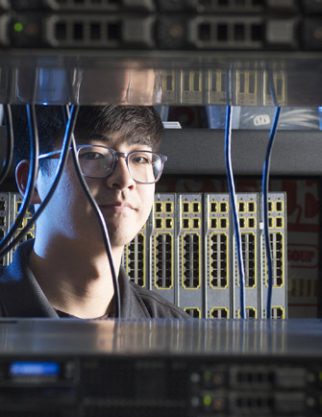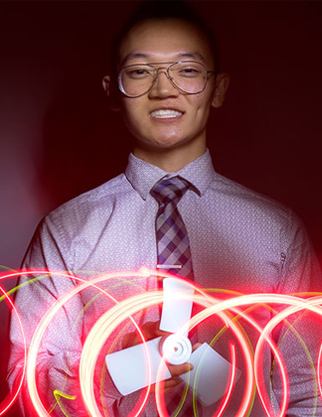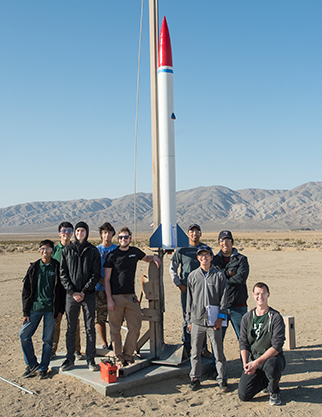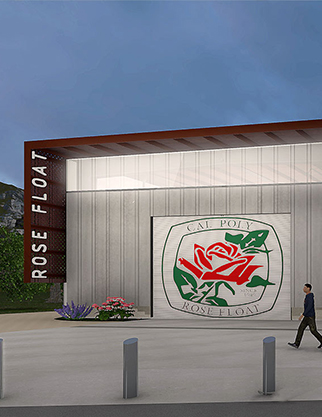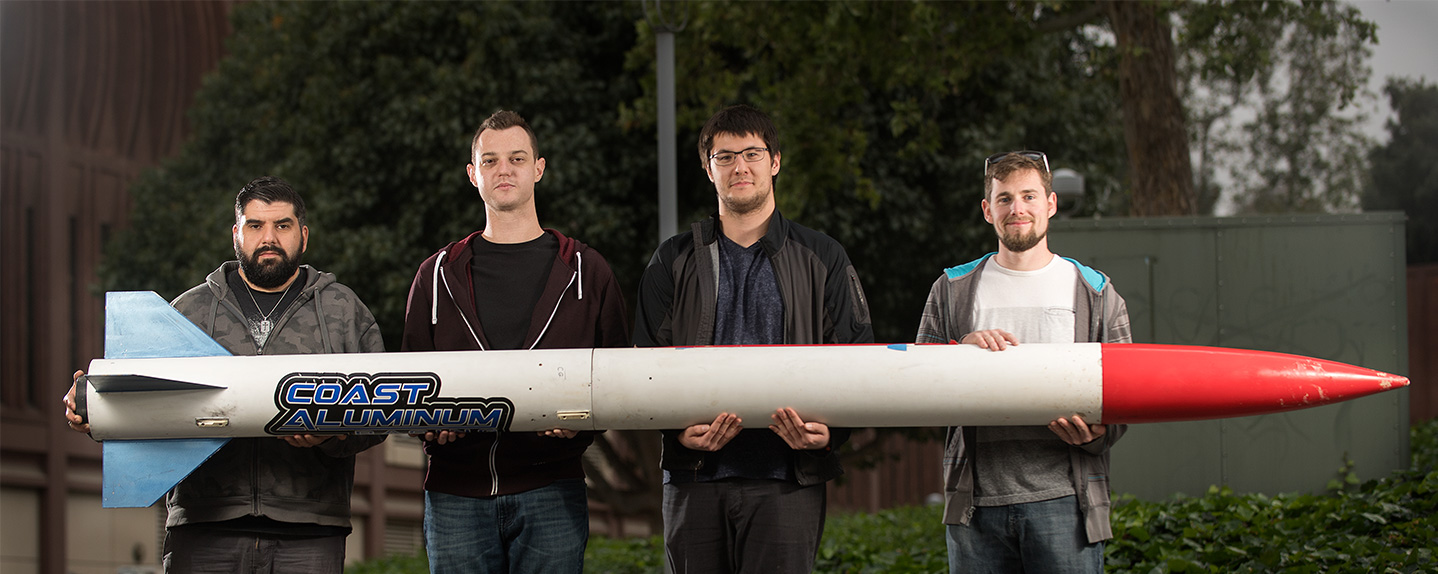Dreams Ignite
Cal Poly Pomona’s Liquid Rocket Lab Launches Journey to Space
An intrepid group of Cal Poly Pomona students and faculty has embarked on an ambitious journey to develop liquid-fueled rockets and establish the Liquid Rocket Lab, with the goal of being the first university to launch a rocket into space.
The project and its lofty objectives are possible thanks to a $1.67 million gift from the National College Resources Foundation.
Fueled by the grant, upcoming competitions and a fascination with discovering the unknown, about 70 students are investing long hours and stretching their talents and imaginations to the limit to design and construct Bronco 1, the university’s first liquid-fueled rocket.
And while experts with decades of experience in the aerospace industry, such as Aerospace Engineering Professor Frank Chandler, are on-hand to share their knowledge and expertise, Bronco 1 is a student-designed, student-built endeavor that brings new meaning to discovery and hands-on learning.
In the spirit of the university’s learn-by-doing credo, students are taking the concept of going to space and making it a reality, according to Chandler. He adds that hands-on learning “is kind of the mantra of Cal Poly Pomona.”
Because rocket science is a precise, methodical process, this journey to space, like all those before it, must follow a complex, prescribed series of steps to reach liftoff.
Bronco 1 is the first of many incremental steps in that voyage. Though not designed to reach space, it’s expected to launch about 45,000 feet into the air.
“Going from where we are right now to be able to put a university vehicle into space — that’s a multiyear effort,” Chandler says.
The student scientists building Bronco 1, as well as the Liquid Rocket Lab itself, are laying a foundation for future students to use as a launch pad to space, which is about 330,000 feet, or 62.5 miles.
To provide motivation and spur ingenuity, the team plans to participate in rocketry competitions along the way.
It’s a long road, but we think we can do it. If we start nailing down these smaller competitions, we can eventually build up to getting our rocket to space,” says Ethan Sichler.Sichler is a senior studying aerospace engineering and oversees the construction of the engine to power the Bronco 1 launch vehicle.
It’s Rocket Science
Bronco 1, the university’s first liquid fuel rocket, will stand more than 15 feet tall once completed, says senior and project leader Richard Picard. It will reach a speed of Mach 1.5 (1.5 times the speed of sound) during its ascent to 45,000 feet, or 8.5 miles. That’s like driving from Cal Poly Pomona to the Claremont Colleges faster than the blink of an eye.
“The rocket will go up and out of sight,” says Picard, who is double majoring in aerospace engineering and physics.
Building a rocket that uses liquid fuel, instead of solid fuel, is an engineering challenge that requires tedious work and many extra hours spent tinkering with their creation.
In the Liquid Rocket Lab in Building 13, students huddle around a plethora of components, large and small, that will ultimately make up Bronco 1. Tiny electrical sensors, complex systems of tubing and valves to carry cryogenic rocket fuel, nose cones, parachutes and tail fins, along with raw materials ranging from wood to high-tech carbon fiber.
Team members speak in an aerospace engineering language of their own that sounds like code to the casual observer.
“We have a lot of TWAs,” Picard says with a grin. “… three-word acronyms.”
The Bronco 1 team is divided into three groups. One is building the complicated liquid-methane burning engine, another is building the rest of the rocket or “launch vehicle,” and the third is creating a mobile rocket engine test stand to allow testing of the powerful engine while anchored to the ground.
Speak Like A Rocket Scientist
3 modules comprise
Bronco 1
Once constructed, Bronco 1 will weigh 115 pounds unfueled, according to Will Morris, a senior majoring in aerospace engineering who heads up the team responsible for the launch vehicle. The rocket’s skin will be made primarily from aluminum and fiberglass, though exotic, aerospace-specific materials are incorporated within the design. The fiberglass nose cone will be tipped with aluminum to prevent it from melting under the heat generated by friction against the air at supersonic speeds.
As the rocket rips through the sound barrier, it will undergo “Max Q,” or the point of maximum force exerted on the rocket by the atmosphere as it races skyward at more than 1,200 mph. The craft must be designed to withstand the considerable forces it will face.
After it reaches the apogee, a small “drogue” parachute will deploy to stabilize its descent and later open a 20-foot-wide canopy at 1,000 feet above the ground to provide a gentle landing.
Redundancy is a theme in Bronco 1’s design, as it is throughout the aerospace industry. Vital components — from fuel venting valves to batteries — are doubled-up, ensuring the flight can proceed safely in the event one of them fails.
Every piece of every component is tested, re-tested, and then tested again. The students are collecting data on all aspects of the vehicle, leaving nothing to chance.
It’s a project that requires dedication, as students spend evenings, weekends and even their spring break in the lab.
I just love this project. It just diminishes everything else. It stretches what we can do as undergrads,” Sichler says. “This whole project has taught me so much, and it’s been such a blast being here.”
A Polytechnic Experience
Many of the concepts that engineering students are learning in the classroom can be applied in the Liquid Rocket Lab. But in some situations, students must take the initiative to research and solve the complex technical issues on their own.
“I’ve learned a lot,” says Donovan Harris, a junior studying aerospace engineering and working on the launch vehicle.
He says that while helping construct the rocket’s propulsion system, he needed to learn and perform calculations that have yet to be covered in his coursework, and he primarily used Google searches as a starting point.
Harris, like many other team members, says he was attracted to aerospace by a lifelong fascination with spaceflight.
“I’ve always loved space. I want to explore it,” Harris says. Upon graduation, he would like to continue working on spacecraft propulsion systems.
Before joining Cal Poly Pomona in 2015, Professor Chandler, one of the half-dozen faculty advisors, spent more than 40 years working on space vehicles for major players such as Rockwell International and Boeing.
The Liquid Rocket Lab is relying heavily on his and other faculty expertise to get off the ground. NCRF and established aerospace companies have also stepped up to donate expertise and hardware to the student project.
“Their main motivation is to help some of our students get involved in rocketry,” Chandler says. “This project is a way for students to get their foot in the door at some of these major aerospace companies and some of these major aerospace programs.”
One of the reasons I came to Cal Poly Pomona was to work on rockets, and getting this program started has been a dream come true.”
And with industry leaders in both the public and private sectors, such as SpaceX and NASA, turning to methane fuel in their latest rocket designs, students with real-world experience in working on liquid-methane rockets will be highly attractive to prospective employers, Chandler says.
“This effort and this experience that they’re gaining is worth millions, he says. “They’re doing great. They’re learning a lot.”
Once Bronco 1 has completed its mission, subsequent teams will begin designing, constructing and testing the next iteration of Cal Poly Pomona liquid rockets, aiming to reach even greater heights. Attaining 62.5 miles — the boundary of space — could become reality in a few short years.
“This is, by far, the most challenging project I’ve ever worked on,” Picard says. “It’s been a wonderful learning experience, though.
“One of the reasons I came to Cal Poly Pomona was to work on rockets, and getting this program started has been a dream come true.”
Published May 17, 2018

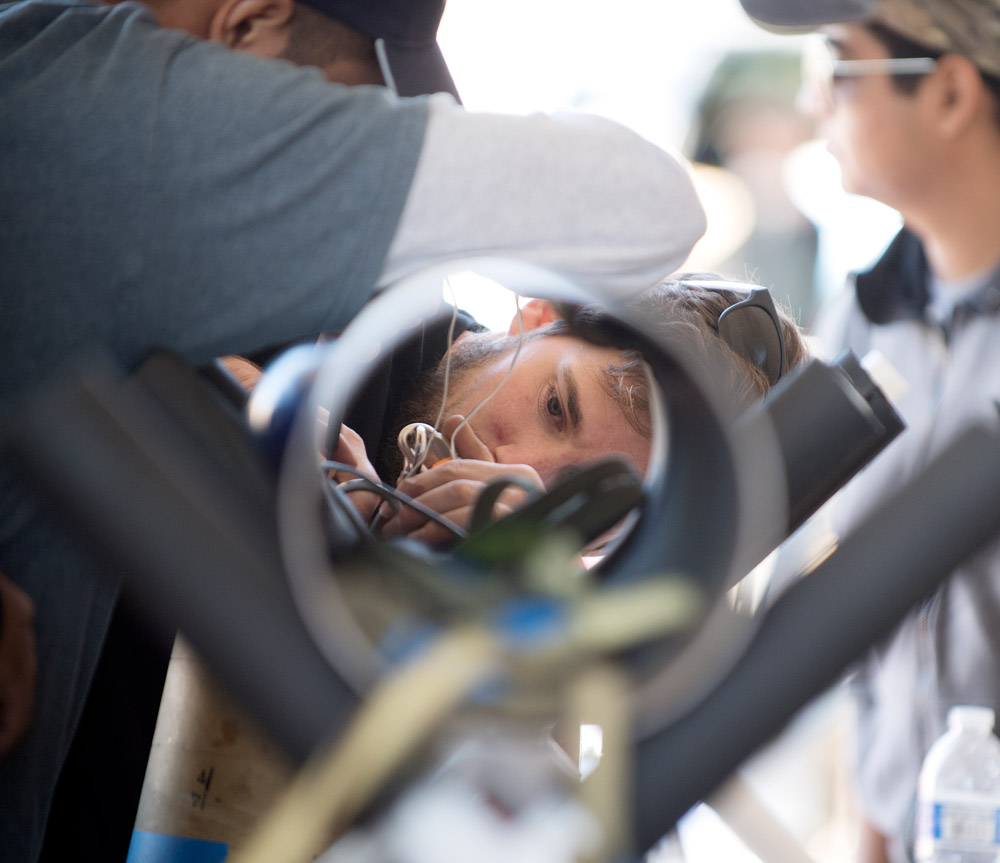


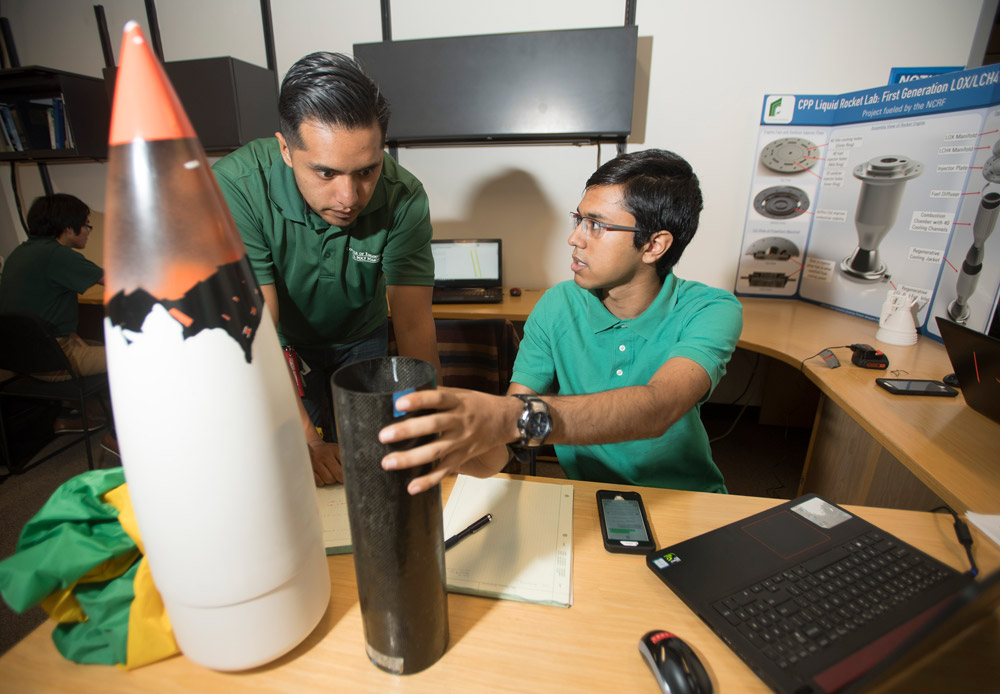
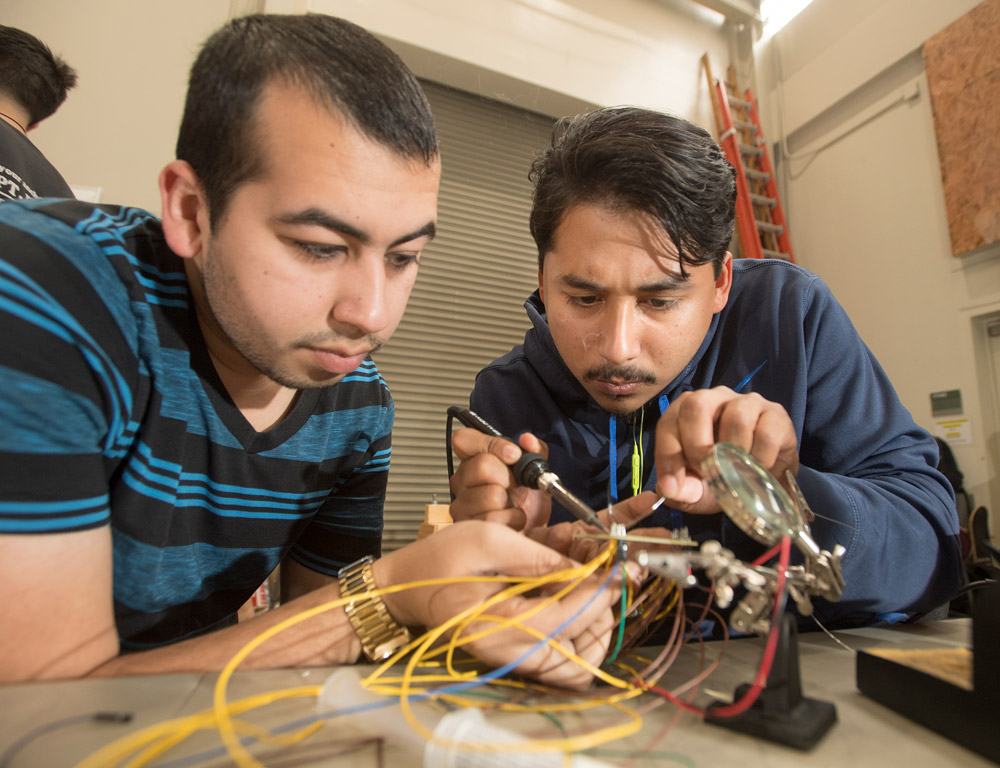
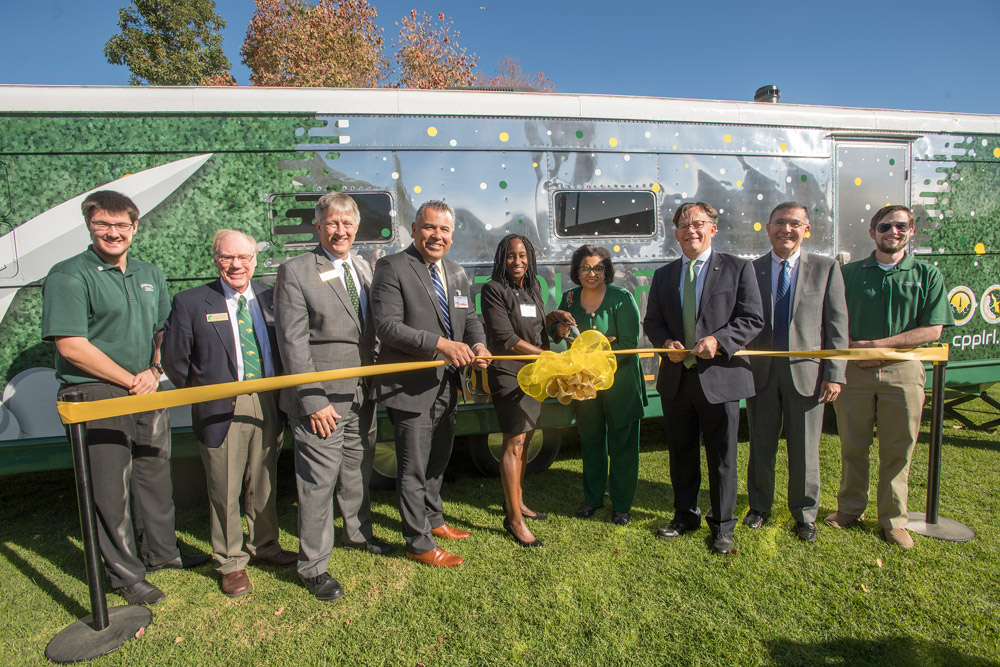
Module 1
Module 1 consists of the nose cone, computer system, and pressurized helium to provide fuel pressure and a two-parachute system to bring it safely back to the ground. It also includes an avionics package with two altimeters, two cameras to record the journey and two different types of GPS systems to help control navigation.
Module 2
The liquid-methane fuel tanks, liquid-oxygen tanks and the intricate network of fuel lines and valves that manage the fuel, which is stored at below 258 degrees Fahrenheit, make up Module 2.
Module 3
Module 3 is the engine, dubbed the CYGNUS Mk1. It will generate 600 pounds of thrust, according to its student designers.





